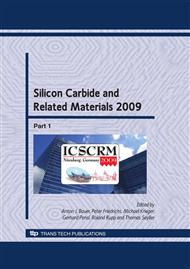p.701
p.705
p.709
p.713
p.717
p.721
p.725
p.729
p.733
Influence of Heating and Cooling Rates of Post-Implantation Annealing Process on Al-Implanted 4H-SiC Epitaxial Samples
Abstract:
We report on topographical, structural and electrical measurements of aluminum-implanted and annealed 4H-SiC epitaxial samples. The influence of heating-up and cooling-down temperature rates on the SiC surface roughness, the crystal volume reordering and the dopant electrical activation was particularly studied. A higher heating-rate was found to preserve the rms roughness for annealing temperatures lower than 1700°C, and to improve the sheet resistance whatever the annealing temperature due to a better dopant activation (except for 1600°C process, which induced a dark zone in the sample volume). A complete activation was calculated for an annealing at 1700°C during 30 minutes, with a ramp-up at 20°C/s. Rising the cooling-down rate appeared to increase the sheet resistance, probably due to a higher concentration of point defects in the implanted layer.
Info:
Periodical:
Pages:
717-720
Citation:
Online since:
April 2010
Price:
Сopyright:
© 2010 Trans Tech Publications Ltd. All Rights Reserved
Share:
Citation:


